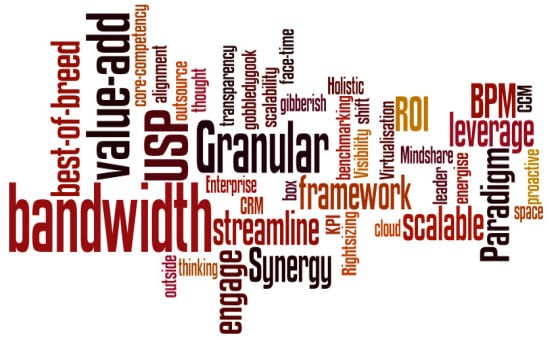We have commented on consulting jargon before, but we will do it again.
Organisations hire management consultants to provide advice on their most challenging business problems. Senior management are busy people, and so consultants need to communicate as clearly as possible.
The need for clarity, however, has not prevented consultants from developing an industry jargon all of their own, which can sometimes be pretty incomprehensible to industry outsiders.
Below we outline some of the jargon that you are likely to come across in the consulting industry.
10,000 foot view: A high-level overview of the situation.
80/20 rule: A rule of thumb which holds that 80% of a business problem can be solved by focusing on 20% of the issues.
Add some color: Make it more interesting/appealing/persuasive.
Adding value: Making a contribution.
AOB: Stands for “any other business” and might be used in a meeting agenda to block out time for miscellaneous discussion.
At the end of the day: A consultant may use this phrase before summarising the main thrust of her argument.
B2B: Stands for “business to business” and indicates that a business is aiming to sell to other businesses rather than to end consumers.
B2C: Stands for “business to consumer” and indicates that a business is aiming to sell directly to consumers rather than to other businesses.
Bandwidth: Capacity to take on additional work commitments. For example, “I don’t have any bandwidth this week”.
Big 3: McKinsey, Bain and BCG.
Big 4: Deloitte, EY, KPMG, PwC.
Boil the ocean: Go overboard; undertake an excessive amount of analysis; fail to follow the 80/20 rule.
Buckets: Categories.
Buy in: Agreement; support. For example, “we need to get buy in from the client before finalising the report”.
CAGR: Compound annual growth rate.
Charge code: A unique code provided for a project which can be used to record work-related expenses.
Circle back: Follow up with someone at a later point in time.
Close the loop: Completing an item on the agenda or topic of discussion with everyone being in agreement.
Core client: A client that has a long-standing relationship with the firm.
Deck: PowerPoint slides.
Deep dive: To conduct an extensive examination of a particular issue.
Deliverable: Work product that a consultant needs to provide to her manager or the client as part of a client engagement.
Development opportunity: A professional shortcoming or area for improvement that requires attention.
Due diligence: Comprehensive examination of all relevant issues, such as a review of the client’s business or industry.
Elevator pitch: A short persuasive summary of a proposal, which leaves the listener wanting to know more.
Fact pack: A pack of information that provides the essential facts for a project/industry/company.
Granular: Focusing on the finer details, as in “this analysis needs to be more granular.”
Hard stop: A stated time after which the person will no longer be available to continue the meeting/discussion. For example, “I have a hard stop at 3 o’clock”.
Key: Critical; essential; required; important; central. For example, “the key issues are X, Y, Z.”
Let me play this back: Words used before providing a summary of the discussion from the listener’s perspective. This is a helpful technique which can allow a consultant to clarify her understanding of the key issues and at the same time sound intelligent by saying something even if the summary adds no additional insights.
Leverage: Make use of.
Low hanging fruit: Targets that are easily achievable, issues that can be quickly resolved, opportunities that can be readily exploited, or problems that are simple to solve. By picking the low hanging fruit first, consultants can demonstrate quick results, which can boost client confidence in the project and help build initial momentum.
Lots of moving parts: Complex.
Managing upwards: Providing feedback to more senior employees.
MBB: McKinsey, Bain and BCG.
MECE: Pronounced “me see”, and stands for “mutually exclusive, collectively exhaustive”. It is a principle developed at McKinsey for grouping information into distinct categories which, taken together, deal with all available options.
On the beach: In between assignments. Time spent on the beach may be spent in training or used for new business development.
On the same page: See things from the same perspective.
Opportunity cost: What you give up in order to pursue an opportunity; the value of the next best alternative.
Out of the box thinking: Lateral thinking; coming up with new ideas which don’t follow neatly from the data.
Ping: Contact someone, as in “I will ping you later via email.”
PIOUTA: Pulled it out of thin air.
Pipeline: Current and upcoming client engagements.
Production: A department of the consulting firm (often outsourced) that assists in producing material needed for presentations and meetings.
Pushback: Resistance or disagreement, as in “we received some pushback from the client.”
Right size: Downsize.
Sandwich feedback technique: A structure for providing feedback that resembles a sandwich – one positive comment, followed by a piece of constructive feedback, and ending with a positive comment.
Scope: Agreed set of deliverables for a client engagement.
Scope creep: When the client adds, or tries to add, additional deliverables which were not agreed in the initial project brief.
Sniff test: A common sense check of a particular idea, proposal or analysis.
SWAG: Some wild-ass guess.
Take the lead: Take responsibility for something, as in: “Why don’t you take the lead on this project.”
Takeaways: The key points that should remembered at the end of a discussion or meeting.
Touch base: To meet at a certain time to talk about the project.
Up or out: Many top consulting firms employ an “up or out” policy. Employees are expected to advance up to the next level of responsibility or they will be counselled out of the firm.
Work stream: The tasks that make up a project.
[For more information on the management consulting industry, download “The HUB’s Guide to Management Consulting“.]
Source: Flickr
